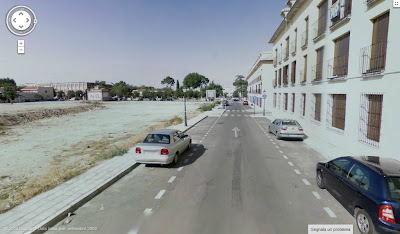You know how dreams can be so vivid, but as
soon as you wake up, they melt away? And how trying to remember them is like clutching at steam?
But you know how there are also some dreams
that don’t fade but instead stay with you,
sometimes for years?
This is my dream that didn’t fade. It
started with a map showing the southernmost tip of South America, which was
very close to Antarctica – much closer in the dream than in real life.
Next thing, I was down there on the coast. I
was standing on a headland of red rock that jutted into the sea, and the water
was calm and a brilliant blue. It was summer.
I saw two people standing in the sea and
thought “The water must be freezing! We’re so close to the Antarctic here!”
I waded into the water and was astonished
to find that it was not cold at all.
“It must be an ocean current coming from
some warm part of the world,” I thought.
The dream was so vivid that I woke up
absolutely convinced that this place really existed. I spent hours on Google
Maps, examining the southern coasts of Chile and Argentina, searching for my
beach. I did search after search for “red headland”, but was just confronted
with endless photos of film director Leslye Headland. (The picture above is the best I could find, but it's not exactly right.)
 |
| Film director Leslie Headland |
I researched the southernmost tips of all
the continents, and I even checked the northernmost points, just in case I had
got my orientation inverted. But it yielded nothing. Anywhere near
the polar regions is just grey rock and snow.
Maybe my beach is a real place, just not
where I thought it was. Maybe I had seen a picture somewhere and when I rehashed
it in my dream, I just located it in the wrong part of the world. But it was
probably entirely a construct of my imagination.
Another imaginary place does actually
exist. I first became aware of it when I heard
En Aranjuez Con Tu Amor, which is surely a contender for Most Beautiful
Song Ever Written:
Here are the words, in the original Spanish and in English:
|
I listened to the song on a loop for a couple of weeks until I was sick of it, then I moved on and thought no more about it.
But I was reminded of it recently when I
came across this picture, Jardí
d’Aranjuez (Glorieta II) by Santiago Rusiñol:
It occurred to me that Aranjuez is an
actual place, not just some name cited in a song. So I Googled some more
pictures and was enchanted:
Aranjuez, it turns out, is a city near
Madrid. It was built by the royal family in the 16th century as their spring
residence and is a UNESCO world heritage site. It is a fairyland of royal
palaces and spectacular gardens with ornate fountains and picturesque riverside
walks. The rich, fertile land yields fat, juicy tomatoes, giant asparagus and luscious
strawberries. Every spring, the Tren de
la Fresa (Strawberry Train) runs along the historic route from Madrid to
Aranjuez, and every passenger is given a plate of strawberries to eat en route.
The locals are enamoured of their city. Blogs
rave about the fusion of history and modern lifestyle. Children grow up happy
in Aranjuez, say the residents, and retired people have an abundance of quiet
places to walk or sit in. It has been the set of numerous films. People who
have spent their lives moving from city to city stop when they get there, and
put down roots, captivated by its charms. It truly appears to be a golden
paradise.
I started obsessing over Aranjuez. I spent
hours looking at pictures of its gardens; I read every forum and resident’s
blog I could find. Since I was in Spain at the time, I even started looking at
trains to go there for a weekend.
But before I went ahead and organised a
trip, I decided to go on a virtual visit courtesy of Google Street View. I put
the little yellow man down in the city centre and waited for Aranjuez to load.
Aranjuez loaded. Aranjuez looked like an
abandoned industrial estate.
“Perhaps I’ve just landed in an unfortunate
place,” I thought, and moved the yellow man to a garden, but had no better luck
there. The garden was surrounded by a high, solid grey wall and you couldn’t
see any of it. I tried another street, and it was just more drab ghost town.
Everything looked dry, blindingly bright
and scorchingly hot. There were no cars on the road, and there were hardly any
people.
“These pictures were probably taken in the
summer in the middle of the afternoon, when everyone was inside to escape from
the heat,” I told myself.
But then I saw that the few people that
were out and about were wearing long sleeves, so it couldn’t have been that summery.
I did the Street View tour of the length
and breadth of the town and found no fountains, no gardens (except those
hidden behind giant walls) and barely any signs of life, only anonymous-looking
blocks of flats, factory loading bays, and some workers emptying a row of recycling bins.
There were some pretty parts of the city,
to be sure, but it was all just so eerie.
In fact, when you go back and look at the
Google search results properly, you see the cracks appearing. Although the
locals do love it (probably the parts of it behind the big walls, though), all
is not rosy. The first discordant note sounds in the form of an article by a
resident, entitled The Price of Living in Aranjuez. It is a privilege to live
there, he concedes, but the problem is that everyone
wants a piece of it. Every morning, the buses and trains are packed with
commuters, and the central station groans under the weight of the people
passing through it.
And the more you look, the more you find.
The city is expanding too quickly. More and more people are moving there, but
the infrastructure is not developing fast enough to accommodate them. The charm
of the city is spoilt by extensive building works, while many of the older
residential buildings are left to fall into a state of disrepair. A lot of
residents prefer to work in Madrid. “Aranjuez = dormitory town!” declares one
resident on a forum.
I suppose the lesson learnt is that
paradise doesn’t exist, and also that residents have insights that tourists
might miss or ignore. I should have known, I suppose.






